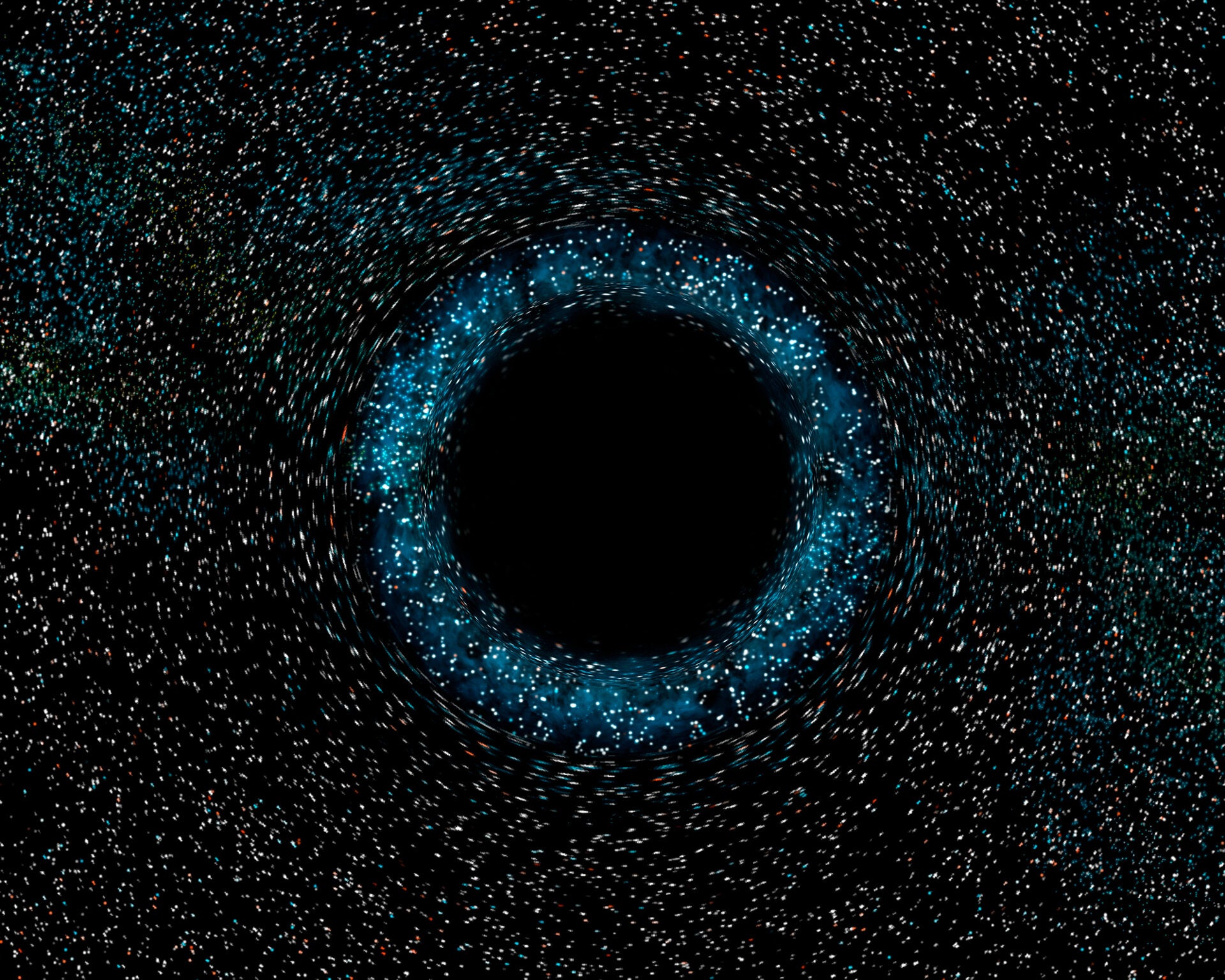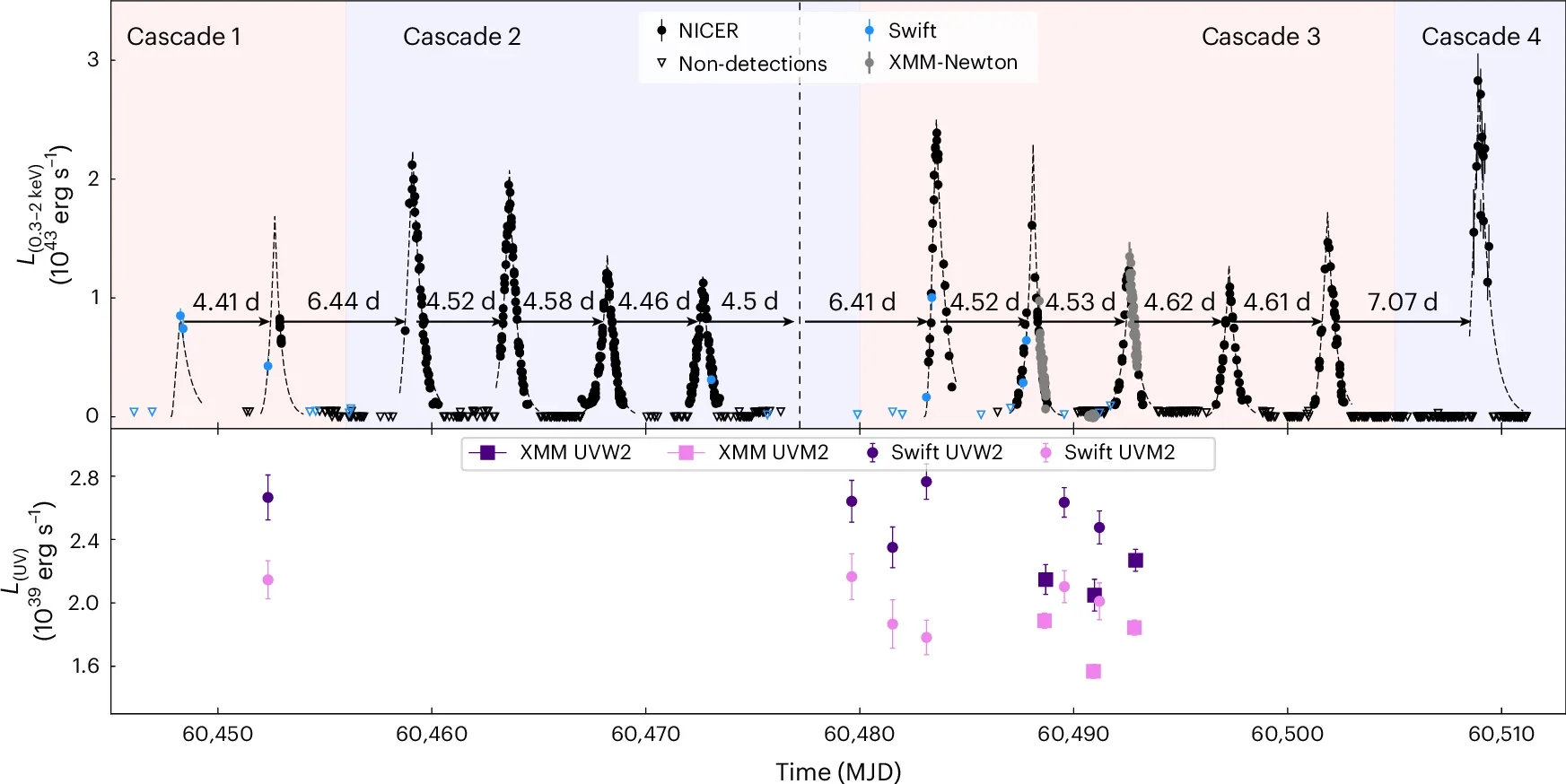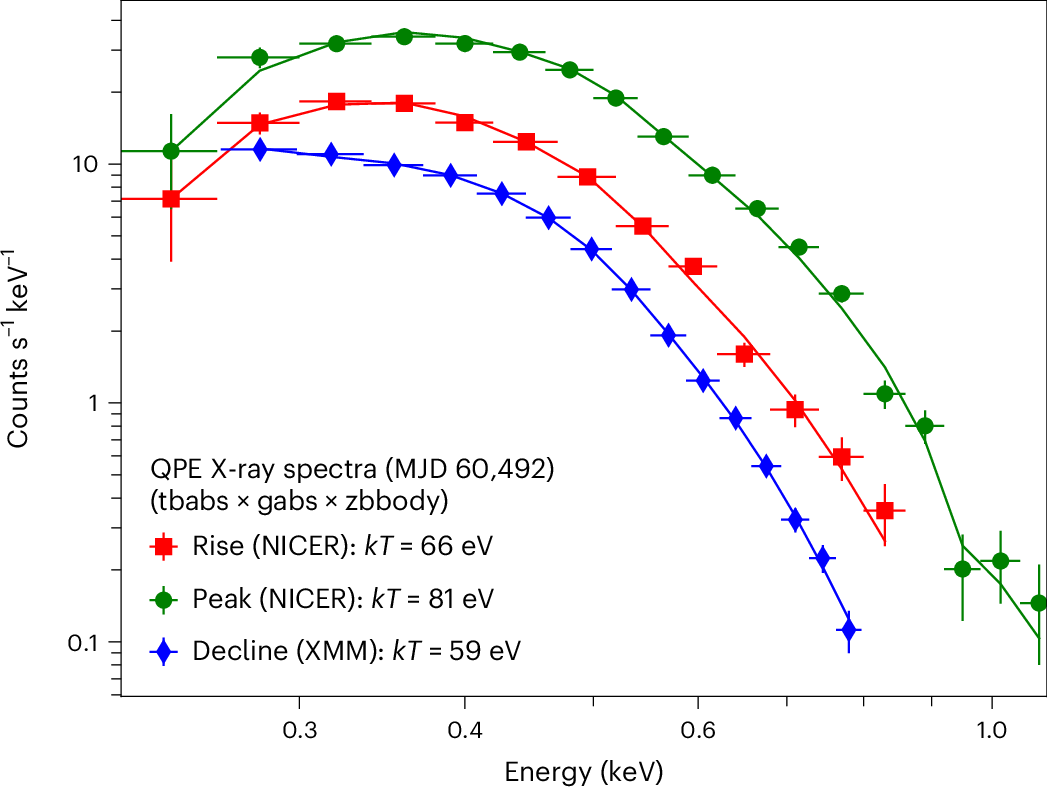A distant galaxy that lay quiet for decades has suddenly stirred, lighting up in dramatic bursts that have caught astronomers off guard. This unexpected awakening, traced to a black hole at the galaxy’s center, offers a rare chance to witness a massive cosmic event in real time.
The galaxy, known as SDSS1335+0728 and located around 300 million light-years away in the Virgo constellation, had shown no signs of activity for twenty years. That changed in December 2019 when its optical brightness surged. At first, the galaxy’s name—ZTF 19acnskyy—was a string of characters logged by the Zwicky Transient Facility. Scientists now refer to this celestial oddity as Ansky, a nickname from that original identifier.
For a long time, the black hole at the heart of Ansky was dormant. Like most supermassive black holes, it sat quietly, not pulling in nearby gas or stars. These black holes are millions of times heavier than our Sun, but unless they are actively feeding, they remain nearly invisible. That quiet period ended when Ansky’s core began to glow.

Paula Sánchez Sáez, a researcher at the European Southern Observatory in Germany, was among the first to respond. “When we first saw Ansky light up in optical images, we triggered follow-up observations using NASA’s Swift X-ray space telescope,” she says. Archived data from the eROSITA X-ray telescope offered no hint of previous emissions.
That made what followed even more striking.
Starting in early 2024, something changed. Lorena Hernández-García, a researcher at Valparaiso University in Chile, began to detect intense, repeating X-ray bursts from Ansky. These weren’t random flashes—they followed a regular cycle, erupting every 4.5 days.
These flashes are called quasi-periodic eruptions, or QPEs. They’re short-lived flaring events seen in X-ray light, and so far, they’ve only been spotted in a few black holes. What makes Ansky remarkable is that this is the first time such eruptions have been detected in a black hole that seems to be newly “waking up.”
Related Stories
Astronomers used several space-based telescopes to watch Ansky, including XMM-Newton, NASA’s NICER telescope aboard the International Space Station, and the Chandra X-ray Observatory. With help from these instruments, researchers captured 12 flares during a 60-day campaign. Each burst lasted around 1.5 days, releasing large amounts of energy before fading until the next pulse.
XMM-Newton’s sensitivity was key. “It is the only X-ray telescope sensitive enough to detect the fainter X-ray background light between the bursts,” Hernández-García explains. By measuring how dim Ansky became between each eruption, her team could estimate the total energy being released.
The pattern of eruptions wasn’t perfectly uniform. In addition to the 4.5-day cycle, researchers noticed a superperiod—a longer rhythm repeating roughly every 25 days. During each cycle, bursts appeared in a cascade of five, followed by a 6.5-day quiet period. Interestingly, one of the expected bursts was missed simply because no telescope was observing the galaxy at that time.

QPEs are thought to result from interactions within a black hole’s accretion disc, a fast-spinning disc of hot matter formed from gas or debris pulled toward the event horizon. Previous QPEs were linked to the destruction of stars, known as tidal disruption events. In those cases, a black hole rips apart a star that gets too close and feeds on the pieces.
But Ansky doesn’t quite fit that mold.
So far, no evidence points to a disintegrated star. Instead, scientists believe that the accretion disc around this black hole may have formed from gas drawn in from its surroundings. The X-ray eruptions might be caused by a smaller object—possibly a star or compact remnant—that repeatedly passes through the disc, disturbing the orbiting matter and triggering powerful flares.
Joheen Chakraborty, a PhD student at the Massachusetts Institute of Technology, notes how different Ansky is from other known QPEs. “The bursts of X-rays from Ansky are ten times longer and ten times more luminous than what we see from a typical QPE,” he says. “Each of these eruptions is releasing a hundred times more energy than we have seen elsewhere.”
That much energy, released on a regular basis, pushes current models to their breaking point.
Ansky’s story didn’t begin with X-rays. It started with light across many wavelengths. By comparing data from ultraviolet, optical, and infrared observations, scientists built a clearer picture of the changes occurring in the galaxy’s center.

Between 2004 and 2021, ultraviolet light from Ansky increased by a factor of four. Mid-infrared light, recorded since 2022, more than doubled. The [O III] emission line—a key marker of ionized gas—grew more than five times stronger over just two years. All of this suggests the black hole is now surrounded by an active, compact, and energetic region, characteristic of active galactic nuclei.
Yet not all signs are typical. No broad emission lines have been seen—features commonly associated with other bright galactic centers. And the optical light curve, while showing a clear pattern, doesn’t match the known behavior of tidal disruption events. The decay of the light is too slow and flat.
Still, the evidence points to a black hole with a mass of about one million times that of the Sun, beginning to feed again. It’s a rare view of a galactic nucleus in the process of turning on.
Archival X-ray surveys like ROSAT and eROSITA never spotted this galaxy, confirming how quiet it was until now. It wasn’t until Swift restarted observations in July 2021 that scientists noticed a change. Even then, X-rays weren’t detected until February 2024.

NICER played a crucial role once monitoring began. The telescope collected data up to 16 times per day, producing one of the most detailed X-ray light curves ever seen for this kind of event.
Why are QPEs so rare? And what makes Ansky’s eruptions so different? Scientists don’t yet have clear answers. Most agree that more data is needed.
“For QPEs, we’re still at the point where we have more models than data,” says ESA Research Fellow and X-ray astronomer Erwan Quintin. “We thought that QPEs were the result of small celestial objects being captured by much larger ones and spiraling down toward them. Ansky’s eruptions seem to be telling us a different story.”
One possibility is that these flares come from a small object disturbing the disc repeatedly, rather than falling in. This kind of repeated interaction could be tied to gravitational waves, and future missions like ESA’s LISA might detect them. Combining those gravitational wave signals with X-ray data could reveal how black holes grow and interact with their environments.

Radio observations of Ansky didn’t show any emissions, ruling out other possible explanations like strong jet activity. That supports the idea that the flares are coming from processes in the accretion disc itself, not from large-scale jets shooting material away from the galaxy.
What makes this discovery even more valuable is that astronomers are watching it unfold in real time. Many other black hole eruptions are spotted only after the fact. Ansky gives researchers a rare front-row seat to the awakening of a cosmic giant.
Note: The article above provided above by The Brighter Side of News.
Like these kind of feel good stories? Get The Brighter Side of News’ newsletter.
The post A sleeping black hole just woke up – erupting powerful x-ray bursts appeared first on The Brighter Side of News.